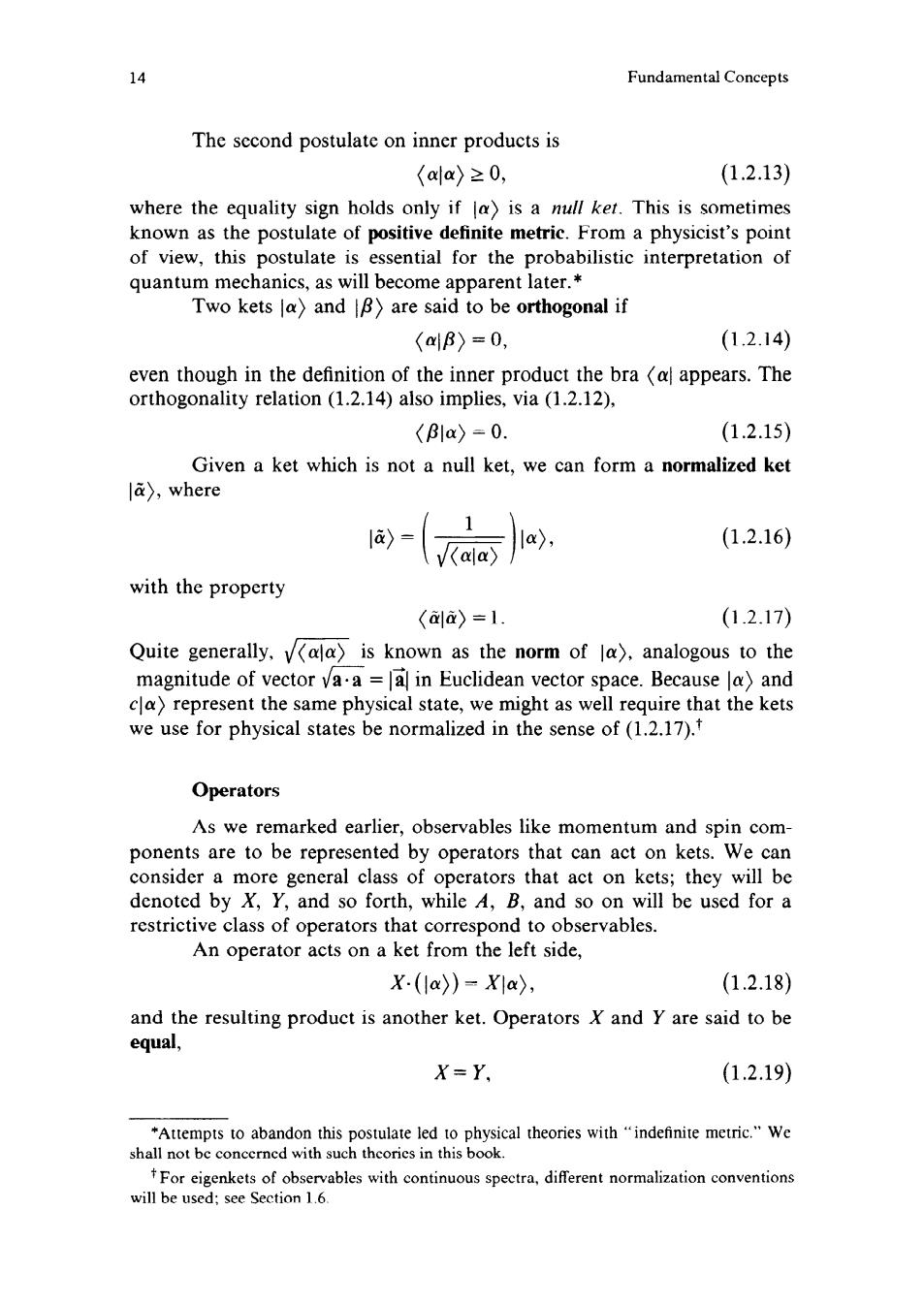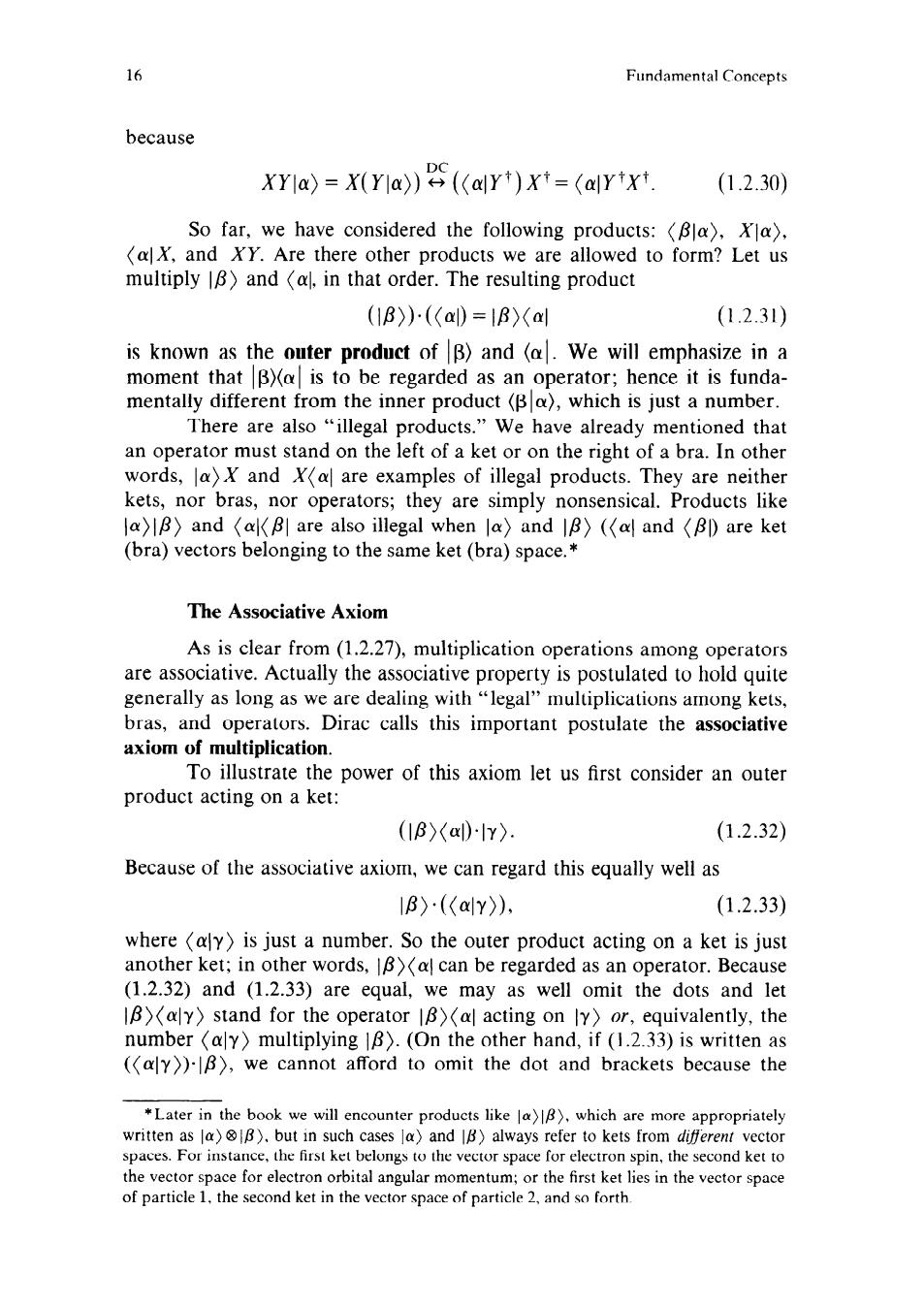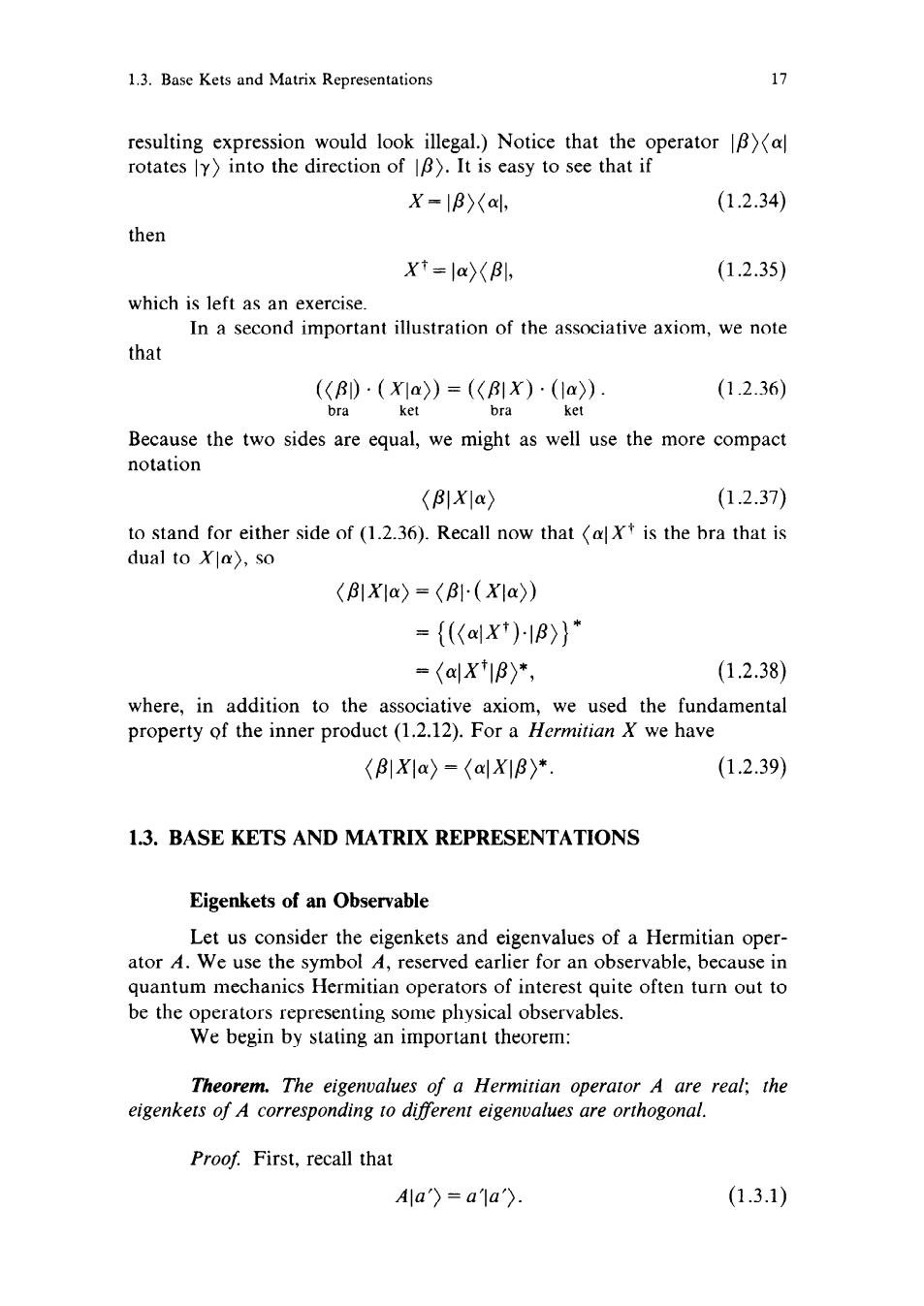
1.2.Kets,Bras.and Operators 13 Bra Space and Inner Products We postulate that corresponding to every ket la)there exists a bra,denoted by (a,in this dual,or bra,space.The bra space is spanned by eigenbras ((a)which correspond to the eigenkets (la')).There is a one-to-one correspondence between a ket space and a bra space: la)(al a)aka (1.2.9) 1a)+1B)S(+(B1 where DC stands for dual correspondence.Roughly speaking,we can regard I to cla)is postulated to be c*nor c(,which is a very important point.More generally,we have cla)+calB)cal+cB. (1.2.10) We now define the inne product of a bra and a ket.*The product is written as a bra standing on the left and a ket standing on the right,for example, (1.2.110 This product is,in general,a complex number.Notice that in forming an inner product we always take one vector from the bra space and one vector from the ket space. We postulate two fundamental properties of inner products.First, 〈1a〉=〈amB)* (1.2.12) In other words,(Bla)and (B)are complex conjugates of each other. Notice that even though the inner product is,in some sense,analogous to the familiar scalar product a-b,(Ba)must be clearly distinguished from aB);the analo 0 s not needed in real ec space becaus a-b is equal to ba.Using(1.2.12)we can immediately deduce that ( must be a real number..To prove this just let〈Bl→〈al "In the literature an inner product is often referred to as a scalar product because it is analogous to ab in Euclidean space:in this book.however.we reserve the term scalar for a quantity invariant under rotations in the usual three-dimensional space

Fundamental Concepts The second postulate on inner products is (ala〉20, (1.2.13) where the equality sign holds only if is a null ket.This is sometimes known as the postulate of positive definite metric.From a physicist's point of view,this postulate is essential for the probabilistic interpretation of (a4B)=0, (1.2.14) even though in the definition of the inner product the bra appears.The orthogonality relation (1.2.14)also implies,via (1.2.12), 〈a)=0. (1.215) Given a ket which is not a null ket,we can form a normalized ket la),where 1 阈-(aaa. (1.2.16) with the property (aa)=1 (1.2.17) Quite generally,V(ala)is known as the norm of la),analogous to the tde of vector aa in Euclidean vector space.Because and la) 〉represent the s same physical state, equire that the kets we use for physical states be normalized in the sense of(1.2.17).t Operators As we remarked earlier,observables like momentum and spin com ponents are to be represented by operators that can act on kets.We can consider a more general class of operators that act on kets;they will be denoted by X,Y,and so forth,while A,B,and so on will be used for a restrictive class of operators that ad to observables An operator acts on a ket from the left side, X(Iax))-X1a), (1.2.18) and the resulting product is another ket.Operators X and Y are said to be equal, X=Y, (1.2.19) "Attempts to abandon this postulate led to physical theories with"indefinite metric."We shall not be concerned with such theories in this book. t For cigenkets of observables with continuous spectra.difterent normalization conventions will be used:see Section 1.6

1.2.Kets,Bras.and Operators 15 if Xla)=Yla) (1.2.20) for an arbitrary ket in the ket space in question.Operator X is said to be the null operator if,for any arbitrary ket a),we have X1a〉=0. (1.2.21) ralarscanheadadadionopeaioasarecommulatneandasaca X+Y=Y+X, (1.2.21a X+(Y+Z)-(X+Y)+Z. (1.2.21b) With the single exception of the time-reversal operator to be considered in Chapter 4,the operators that appear in this book are all linear,that is, X(cala)+cplB))=caXla)+cexB) (1.2.22) An operator X always acts on a bra from the right side (al).X=<alX. (1.2.23) Xla)(alx. (1.2.24) The operator Xt is called the Hermitian adjoint,or simply the adjoint,of X. An operator X is said to be Hermitian if X-Xt (1.2.25) Multiplication Operators X and Y can be multiplied.Multiplication operations are, in general,noncommutative.that is, XY+YX. (1.2.26) Multiplication operations are,however,associative: X(YZ)=(XY)Z=XYZ. (1.2.27) We also have X(Yla))=(XY)la)=XYja), (1X)Y=〈B(XY)=(BXY. (1.2.28) Notice that (xY)=Yfxt (1.2.29)

Fundamental Concepts because XYIa)=X(Yl@))((alr')xt-(alrtxt. (1.2.30) So far,we have considered the following products:(Bla).X). (X,and XY.Are there other products we are allowed to form?Let us multiply B)and (al,in that order.The resulting product (1B>)-((al)=1B)(al (1.2.31) is known as the outer product of B)and (a.We will emphasize in a moment that B)(o is to be regarded as an operator;hence it is funda- mentally different from the inner product (Ba),which is just a number. opeue entioned that words,la)X and X(a are examples of illegal products.They are neither kets,nor bras,nor operators;they are simply nonsensical.Products like The Associative Axiom As is clear from(1.2.27),multiplication operations among op erators are associative.Actually the associative property is postulated to hold quite generally as long as we are dealing with "legal"multiplications among kets, bras,and operators.Dirac calls this important postulate the associative axiom of multiplication To illustrate the power of this axiom let us first consider an outer product acting on a ket: (IB)(aD)-ly>. (1.2.32) Because of the associative axiom,we can regard this equally well as IB)·(aY), (1.2.33) where (aly)is just a number.So the outer product acting on a ket is just another ket;in other words,B)(can be regarded as an operator.Because (1.2.32)and (1.2.33)are equal,we may as well omit the dots and let (stand for the operator (acting on r equivalently,the number (aly)multiplying B).(On the other hand,if (1.2.33)is written as ((aly))B),we cannot afford to omit the dot and brackets because the we will encounter 09 s like la)lB,which are more approprately the vector space for electro bital anguar momentum:or the first ket lis in the vector space of particle 1.the second ket in the vector space of particle 2,and so forth

1.3.Base Kets and Matrix Representations 1 resulting expression would look illegal.)Notice that the operator B) rotates ly>into the direction of B).It is easy to see that if X-lβ>a, (1.2.34) then xt=la)Bl, (1.2.35) which is left as an exercise. In a second important illustration of the associative axiom,we note that (D·(X1a)=(1X)·(Ia) (1.2.36) hra ket hr ket Because the two sides are equal,we might as well use the more compact notation <BIXla) (1.2.37) to stand for either side of (1.2.36).Recall now that is the bra that is dual to xla),so BIXla)=<B1-(Xla)) ={(aX)川B)} =(aX1B)*, (1.2.38) where,in addition to the associative axiom,we used the fundamental property of the inner product (1.2.12).For a Hermitian X we have <BIXla)-<alXIB)*. (1.2.39) 1.3.BASE KETS AND MATRIX REPRESENTATIONS Eigenkets of an Observable Let us consider the eigenkets and eigenvalues of a Hermitian oper- ator A.We use the symbol A,reserved earlier for an observable,because in quantum mechanics Hermitian operators of interest quite often turn out to be the operators representing some physical observables We begin by stating an important theorem: Theorem.The eigenvalues of a Hermitian operator A are real;the eigenkets of A corresponding to different eigenvalues are orthogonal. Proof.First,recall that A川a)=a1a). (1.3.1)